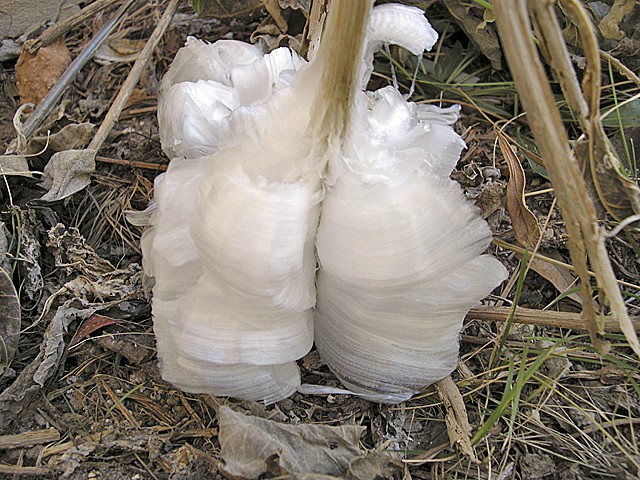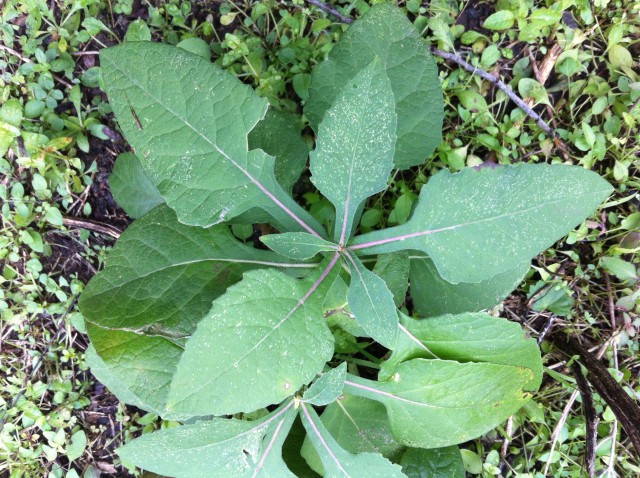
This example of “ice flowers” occurred in the Austin area in 2010. Notice that the ice threads are near the bottom of a withered stem of Frostweed. The ice formations can take on a variety of shapes: flowers, ribbons, bows, clams….even potato chips! Myra Allison photo.
08 Jan 2016 – Cold Weather May Bring “Ice Flowers”
Each season of the year has its own beauty. Spring and summer are green, luxuriant, and filled with the colorful flowers and fruits. Fall and winter are the “brown” months. But even so, the leafless trees and dry grass can dazzle us when they are decorated with the many forms of ice.
South Texas gets cold, but only rarely cold enough to form ice. So when we have snow or an ice storm, or maybe just a frost, we are excited. I recall the morning I woke up to the first frost earlier this fall. It had gotten down to 30 degrees on our farm. Everything glittered. But an hour later it was gone and left behind were the mushy, black remains of my tomato and pepper plants. We haven’t had a freeze since.
I remain hopeful. This winter was predicted to be cold and stormy. And February is supposed to be our coldest month. Surely there will be more ice before it is all over.
I think this may be the winter in which I will see “ice flowers.” Ice flowers occur only under specific weather conditions and only on certain kinds of plants. Many naturalists see them only once in their lifetimes.
Why am I so sure that I will get to see ice flowers? Well, I have been studying up on them and I know the conditions required for their formation.
First, you must have the right kind of plant. It needs to be a perennial, preferably one that grows well in the fall. Its roots need to be alive for the phenomenon to happen. The top part of the plant can be dead and brown. Around here, the best plant is a hardy native called Frostweed.

Frostweed is a common wildflower in Texas and surrounding states. It grows up during the summer, defying heat and drought, and flowers in the fall. Late-season blossoms provide a lot of nectar for butterflies and bees. Even after frost knocks back the plant’s top, its roots will continue to take on water. Sometimes, this can result in the peculiar phenomenon called “crystallofolia.” Karen Benson photo.
Frostweed (Verbesina virginica) is aptly named. It grows best in the late summer and blooms during the fall. The three-foot tall plants are topped by a crown of small white flowers that are very attractive to butterflies. Frostweed is one of the best nectar-producing wild flowers in the fall. It will bloom right up until the first frost. But even when knocked back by a freeze, the frostweed can “bloom again.” These new blossoms are made of ice!
Can you image taking a walk in the woods on a frosty morning and spying what looks to be cotton balls on the bases of dead weeds? Or the masses of white may look like “strips of Styrofoam clinging to the lower stems of dead plants.” Taking a closer look (and touch) you would see that these white masses are made of ice, and a very delicate form of ice at that. The cold threads of ice would disintegrate on your fingers. It is these strange formations that give Frostweed its name. (You can see why it is also sometimes called Iceplant and these formations called “ice flowers.”)
In his Remarkable Plants of Texas (2009), Matt Warnock Turner describes “ice flowers” taking on other fantastic shapes. They may “resemble flowers, bows, potato chips, and clams. Frequently, as if squeezed through a cake-decorating tube, the ice appears in delicate ribbons, with wavy or fluted edges, which sometimes turn back on themselves like Christmas ribbon candy.”
How do these “frozen whimsies” form? Of course, you must have freezing temperatures. But the soil itself must be above freezing and very moist. The Frostweed’s roots need to be alive and functioning, although the leaves and stems may be completely withered. These conditions often occur in the fall when a good rain (with above freezing temperatures) is followed by a hard freeze.
The process goes like this: First, the temperature of the air suddenly drops to below 32 degrees. The roots are still absorbing water and transporting it through the plant’s plumbing, the tubes called xylem. The roots, however, can only push the water up so far before it freezes, usually just a few inches above the ground. As the water freezes, it expands, breaking the xylem tubes in the stem. (This is breakage is easier if the stem is dry and brittle.) The first ice formed is squeezed out through the tiny cracks by more water coming up the stem from below. That water, in turn, freezes as it hits the surface. The result is a long thread or ribbon of ice, curling outward. Since there are usually many tiny cracks in rows along the stem, the ice formations can take the shape of petals or “potato chips.”
Biologists have struggled to come up with an appropriate name for this phenomenon. “Frost flowers” has been used but since the ice formations are neither “frost” nor “flowers” it is obviously not the best term. “Ice flowers” is only a little better. German botanists in the 19th century likened the ice growing out of the stem to the making of a leaf, and thus used the term “Eisblatt” or ice-leaf. Bob Harms, of the University of Texas, has coined the word “crystallofolia” for the phenomenon. Crystallofolia (which means ice-leaf in Latin) is catching on as suitably scientific name. In fact, the Internet has several sites with this name. And the photographs on these sites are fascinating!
Fewer than thirty species of plants have been observed to exhibit crystallofolia. But since one of them is the Frostweed, a common plant in Texas, I think my chances are good at seeing “ice flowers.” I have flagged a dozen or so Frostweed plants on my property. They are shade-lovers and are mostly near the edges of the brush. I check on them often but I am waiting for the prime conditions: a good rain followed by a hard freeze. It is raining now as I write. And a freeze is predicted for later this week. My chances are very good indeed!
If you would like to offer comments, please click through to the discussion page
